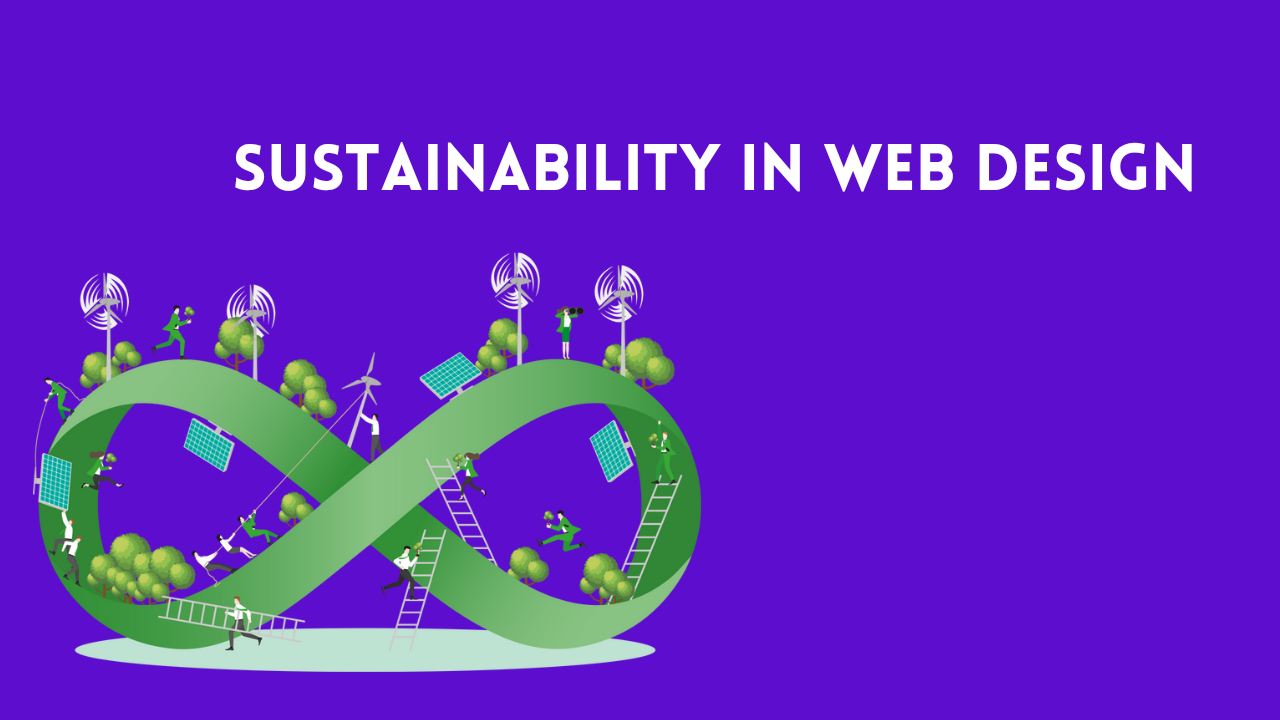Sustainability in Web Design: Reducing Digital Carbon Footprints
August 31, 2024 | by codimatesolutions

Introduction to Sustainable Web Design
In an era where digital technology pervades nearly every aspect of daily life, the environmental impact of the internet has become an important consideration. Sustainable web design emerges as a critical initiative aimed at mitigating these impacts, ensuring that our online activities contribute as little as possible to the global carbon footprint. As websites become more sophisticated and data-intensive, the energy required to power and cool the servers that host them increases correspondingly. This, in turn, necessitates a closer look at how we can make web design practices more eco-friendly.
The importance of sustainability in web design is multifaceted. First and foremost, it addresses the environmental consequences associated with the internet. Data centers, which store and manage digital content, are significant consumers of electricity. This electricity often comes from non-renewable sources, thereby contributing to greenhouse gas emissions. By implementing sustainable web design principles, developers can reduce energy consumption through optimized code, efficient resource use, and streamlined user experiences.
Furthermore, there is a growing consumer demand for environmentally responsible practices across all industries, including technology. Users are becoming more cognizant of the ecological footprint of their digital interactions. As a result, businesses can bolster their brand reputation and customer loyalty by adopting sustainable web design practices. Emphasizing eco-friendly measures can also become a differentiator in a competitive market, appealing to an increasingly eco-conscious audience.
Ultimately, sustainable web design is not only about reducing digital carbon footprints but also about creating a more responsible and ethical digital landscape. Web designers and developers are in a unique position to lead this charge, incorporating sustainability into the very fabric of their projects. By prioritizing efficiency, minimizing waste, and leveraging renewable energy sources, the industry can make significant strides toward a more sustainable future.
Understanding Digital Carbon Footprints
Digital carbon footprints refer to the amount of carbon dioxide (CO2) emissions generated by online activities. Every action taken on the internet, from browsing websites to streaming videos, involves the consumption of energy. This energy consumption in turn contributes to the carbon emissions associated with powering the servers, data centers, and complex global internet infrastructure that supports the web.
The process of delivering web content to users across the globe relies heavily on data centers. These facilities house vast numbers of servers, which require significant amounts of electricity to operate and cool. The larger the data center, the greater the energy consumption, leading to higher carbon emissions. A considerable portion of this energy often comes from non-renewable sources, further exacerbating environmental concerns.
Web hosting providers also play a crucial role in the generation of digital carbon footprints. Depending on their energy sources, the carbon impact of hosting services can vary significantly. Providers that utilize renewable energy or energy-efficient technologies contribute less to the overall carbon emissions compared to those reliant on fossil fuels.
Additionally, the global internet infrastructure, comprising undersea cables, satellite systems, and network equipment, demands a substantial amount of energy for operation and maintenance. As the demand for online services grows, so does the need for infrastructure expansion, amplifying the environmental impact.
Understanding the relationship between online behaviors and energy consumption is essential for addressing the challenge of digital carbon footprints. By recognizing the environmental cost associated with web usage, individuals and organizations can make more informed decisions aimed at reducing their carbon emissions and fostering sustainable practices in web design and digital activities.
Principles of Sustainable Web Design
In the realm of digital innovation, sustainable web design has emerged as a critical discipline aimed at minimizing the environmental impact of online activities. One of the fundamental principles of sustainable web design is the construction of lightweight websites. By reducing the overall size of a website, we inherently reduce the amount of data that needs to be transmitted, which, in turn, decreases energy consumption. Lightweight construction includes the use of optimized images, streamlined layouts, and minimalistic approaches to design that favor simplicity and efficiency over extraneous elements.
Efficient coding practices play an equally pivotal role in sustainable web design. Writing clean, streamlined code not only boosts website performance but also curtails energy usage. Employing modern coding standards and minimizing the use of redundant scripts ensures that websites run smoother and faster, thus contributing to a lower digital carbon footprint. Additionally, making use of asynchronous loading for non-critical elements can help lessen the server load and improve overall energy efficiency.
Sustainability in web design is further achieved through optimization techniques. These techniques often involve compressing text and multimedia content, leveraging browser caching, and enhancing server response times. For instance, image optimization through formats like WebP offers significant reductions in file size without compromising quality. Enabling gzip compression for website files is another effective strategy that reduces the amount of data that servers need to handle, thereby lowering energy consumption.
Adopting a performance-first approach can radically improve user experience while also contributing to sustainability goals. Efficiently designed websites not only facilitate faster load times but also reduce abandonment rates, promoting higher user engagement with lower environmental costs. In essence, sustainable web design mandates a conscientious approach that balances aesthetics, functionality, and environmental responsibility. Each of these elements—from lightweight website construction to efficient coding practices and comprehensive optimization techniques—forms the bedrock of an eco-friendly digital presence.
Creating Lightweight Websites
In recent years, the focus on sustainable web design has become a pressing priority for developers and designers alike. One of the pivotal strategies in this green initiative is the creation of lightweight websites, which not only enhance user experience by loading faster but also contribute significantly to reducing digital carbon footprints. One critical aspect is the cautious use of high-resolution images and videos. While visually appealing, these heavy files can drastically slow down websites. Instead, designers should consider using compressed images and video formats that retain quality without consuming excessive bandwidth.
Another approach is to use efficient file formats. For images, formats like WebP and SVG are preferable because they offer higher compression ratios without substantial loss of quality. Similarly, for videos, using codecs like H.265 (HEVC) can achieve significant size reductions. Additionally, stopping autoplay for videos unless absolutely necessary can prevent unnecessary data usage.
Leveraging responsive design is equally critical for building lightweight websites. By ensuring that content adapts seamlessly to various screen sizes, developers can enhance usability across different devices without loading unnecessary elements. Media queries and flexible grids can help in structuring a responsive design effectively, ensuring content is only loaded when and where it is needed.
Another pivotal element is optimizing web assets. Employing techniques such as lazy loading, where images and videos are only loaded as they come into the user’s viewport, can significantly reduce initial load times. Minifying CSS, JavaScript, and HTML files, as well as combining files to reduce server requests, can also lead to more efficient resource use.
By thoughtfully integrating these strategies, developers can build not only high-performing websites but also contribute to a more sustainable digital environment. These efforts help reduce the energy consumption associated with web browsing, thus playing a part in decreasing the overall carbon emissions tied to the internet. Ultimately, every step towards optimizing web assets and creating lightweight websites brings us closer to a greener web.
Optimizing Site Performance
Optimizing site performance plays a vital role in enhancing user experience and promoting sustainability. One of the most effective methods to achieve this is through caching techniques. By storing elements of a webpage for future requests, caching reduces the amount of data transfer needed between the user and server, resulting in quicker load times and reduced energy consumption.
Server-side optimization is another crucial aspect. This involves refining the performance of the server itself, from upgrading hardware to configuring efficient software setups. Utilizing technologies like HTTP/2 can significantly improve performance by allowing multiple requests to be sent on the same connection, thus speeding up data delivery. Additionally, implementing server-side scripting optimizations can minimize the processing time and resources needed to serve web pages.
Content Delivery Networks (CDNs) offer a practical solution to enhance site performance globally. CDNs distribute copies of your website content across various geographical locations, ensuring that users access a server closer to their location. This reduces latency, speeds up page load times, and decreases the energy used during data transmission. By minimizing the distance data travels, CDNs can effectively lower the website’s carbon footprint.
Regular website audits form an integral part of maintaining optimal site performance. Periodic checks allow web administrators to identify and rectify performance bottlenecks, outdated content, and inefficient code. Audits can include assessing loading times, checking for broken links, and verifying the consolidation of external scripts. Employing tools such as Google PageSpeed Insights or GTmetrix can provide a detailed analysis and actionable recommendations for improving site performance.
Incorporating these optimization techniques not only enhances the user experience by providing faster, more responsive websites but also contributes to the larger objective of sustainability. As the digital landscape continually evolves, regular updates and performance tuning are essential to maintaining a website that is both efficient and environmentally responsible.
Green Hosting Solutions
In the evolving landscape of web design, embracing sustainability goes beyond optimizing website performance and aesthetics. Green hosting solutions represent a critical aspect of reducing the overall digital carbon footprint. These hosting options prioritize renewable energy usage, minimizing the environmental impact of running websites and fostering a more sustainable digital environment.
Several companies have emerged as pioneers in green web hosting, offering services that marry reliability with eco-conscious practices. One such provider is GreenGeeks, which offsets its energy usage by investing three times the amount of energy it consumes in wind energy credits. This approach ensures that their operations are not only carbon-neutral but contribute positively to renewable energy generation.
Another notable player is A2 Hosting. Known for its “FutureServe Green Hosting” initiative, A2 Hosting sources its power from renewable energy and actively participates in reforestation projects. By choosing such a provider, businesses support a host that is committed to making a tangible difference in reducing carbon emissions associated with web hosting.
Eco-friendly hosting extends beyond energy sources to include efficient infrastructure and operational practices. For instance, SiteGround employs energy-efficient data centers and partners with Google Cloud, which matches 100% of the energy consumed by their operations with renewable energy. This commitment ensures that the carbon footprint associated with hosting services is significantly reduced.
Choosing green web hosting comes with numerous benefits for environmentally conscious businesses. Not only does it align with sustainable values, but it also enhances brand reputation among eco-aware consumers. Moreover, utilizing renewable energy resources helps mitigate the adverse impacts of climate change, fostering a healthier planet for future generations. Companies that adopt these solutions demonstrate leadership in corporate responsibility, setting a benchmark in sustainable digital practices.
Incorporating green hosting solutions is an impactful step towards achieving broader sustainability goals. As the digital realm continues to expand, the adoption of eco-friendly hosting practices will play an essential role in shaping a sustainable future.
Designing for Longevity
Designing for longevity is a crucial component of sustainable web design, aimed at creating websites that stay efficient and relevant in the long-term. This approach not only enhances user experience but also reduces the digital carbon footprint by minimizing the need for frequent redesigns and updates. One effective strategy is to adopt modular design principles. Modular design allows developers to break down complex website structures into smaller, reusable components. These modules can be easily updated or replaced without affecting the entire site, ensuring adaptability and ease of maintenance.
Scalable structures are another essential aspect of designing for longevity. Scalability refers to the ability of a website to handle growth, whether it’s an increase in content volume, user traffic, or the integration of new technologies. By building a scalable architecture, websites can accommodate future needs without significant alterations or overhauls. Utilizing scalable frameworks and coding practices can greatly contribute to a website’s ability to evolve over time, ensuring it remains efficient and functional.
Future-proofing content management systems (CMS) is also critical in sustainable web design. A robust and versatile CMS allows for seamless content updates, integration of new features, and compatibility with emerging technologies. When selecting a CMS, it’s important to consider its flexibility, ease of use, and support for updates. An ideal CMS should offer a variety of plugins and extensions that can enhance functionality and provide options for future modifications. By choosing a future-proof CMS, web designers can ensure that their websites remain relevant and capable of meeting evolving user demands.
Case Studies and Best Practices
In the quest for sustainability in web design, numerous organizations have pioneered the implementation of eco-friendly digital practices. Codimate Solutions is passionate about creating websites that are not only visually appealing and highly functional but also environmentally friendly. As the digital landscape grows, so does the importance of sustainability in web design. They are committed to implementing eco-friendly practices that reduce the carbon footprint of their projects.
One of the key strategies they employ is optimizing code efficiency. By writing clean, streamlined code, Codimate Solutions ensures that their websites run smoothly without consuming unnecessary energy. This results in faster load times for users and less energy used by servers, contributing to a more sustainable internet.
Another critical element in their approach is image optimization. Codimate Solutions compresses images to the smallest possible size without compromising quality. This reduces the amount of data that needs to be transferred, lowering energy usage and speeding up the user experience.
They also minimize the use of JavaScript wherever possible. By reducing reliance on resource-heavy scripts, they cut down on the energy required to process them. This not only makes their websites more efficient but also helps in reducing their overall environmental impact.
Furthermore, they implement server-side rendering and streamlined CSS. These techniques ensure that their websites load quickly and efficiently, using less energy while providing a seamless experience for users.
Codimate Solutions believes in the power of small changes to make a big difference. By integrating sustainable practices into their web design process, they are helping to create a greener internet—one website at a time.
RELATED POSTS
View all



